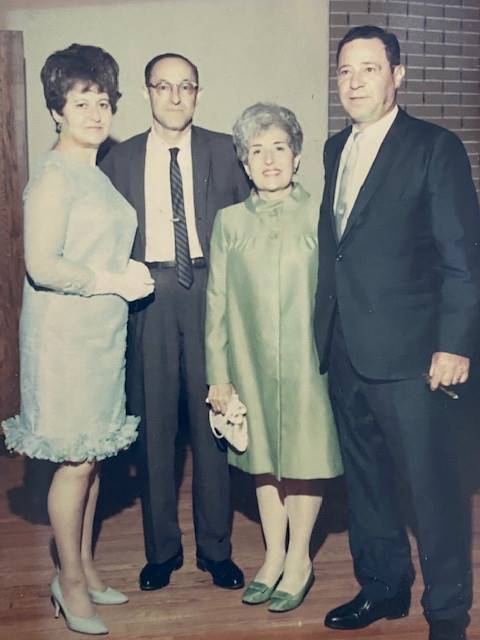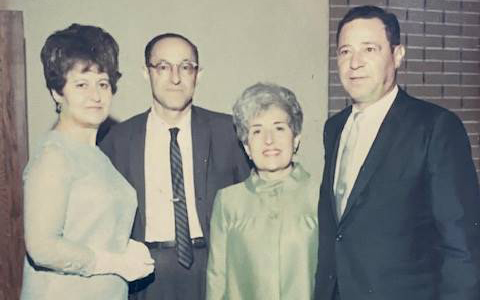By Bonnie Burman
Who’s your Patty?
I remember the first holiday season after my mother’s dementia diagnosis and her move into the nursing home so clearly, even though it was almost 20 years ago.
That December, though we arrived together as a family to visit her from near and far, we were definitely NOT on the same page about the care we thought she should be receiving or the outcomes we sought. For example, my oldest brother, Sandy, thought it was ok that she stayed in her room and watched TV much of the day; I thought she should be participating in the many activities offered. (The social worker broke the tie when she told us that my mother’s preference was to stay in her room). My other brother, Kenny, thought that my mother should be corrected when she called someone by the wrong name or confused them with someone else; her sister, Rose, thought it was ok and not a big deal, especially given her diagnosis. The biggest debate by far, however, was over the picture of one of her “grandchildren” that she loved to show visitors with pride. We had no idea who this little boy was or where she had gotten the picture from. I celebrated him along with her; one of my older brothers was very upset by the situation and he wanted the picture removed. I distinctly remember Sandy, saying to me sternly, “So, what you are saying, Bonnie, is that if we just listen to you and do everything YOUR way everything will be ok?”
While we had arrived together to support and care for my mother, I could feel in that moment just how far apart we all were. I realized in that moment that we had a conundrum on our hands: how could we care about my mother if we didn’t understand what caring about a person with dementia actually meant? How were we supposed to figure it out if we could no longer ask my mother what she wanted in the same ways?
Boy, did we need help — and we actually got it!
It turns out that the best presents my mother—and all of us—received that year were not from one of us but instead came from the care community’s hair stylist Patty, who gave us the beautiful gift of understanding, and my mom’s care team who patiently helped us apply the principles we were learning.
Here is what happened: When Patty came to pick up my mother, as she did every Friday morning, she noticed a photograph on the bedside table of my mother and her “forever” best friend, Shaney, taken many years ago. Just then she had an idea. She thought: What if she “did” my mother’s hair in that special style that was in the photo? Might it bring back some memories? We all agreed that it was worth a try.

And that is what Patty did—she “set” my mother’s hair swooped up high above her head, wrapped slightly towards the front and gently placed across her forehead, sprayed so much it couldn’t move an inch. As she looked at herself in the mirror, my mother LOVED what she saw. We watched her eyes light up and we imagined that she saw herself back at the time the photograph was taken. Slowly, it worked: my mother had traveled back to the time the photo was taken, and she began to share one story after another, as if they were happening now. Did we stop and correct her? Tell her that she was not in the 1960s and that Shaney was not there in the room with her? What was the protocol? We were totally unprepared for this new experience.
We were advised by her care team to “go with it” and not to correct her about the current year or where she was. Instead of being sticklers for details and chronology, we learned something else about meeting someone where they are, and about flexibility in the face of dementia, a state that questions time and chronology entirely. We learned that this destabilizing quality, while many times frustrating to care partners, can also bring joy: the joy of reminiscing and of re-experiencing beautiful memories. Through this experience we learned a great deal, and we felt closer to each other and to my mother. As she continued to reminisce, the visits were lovely and lively. We talked about the past and we learned to “go with flow.” And, importantly, we started to listen differently to each other, which certainly helped my mother’s care partners.
When I look back on that time, I realize how important the experience was to me and how it helped start me on my journey in person-centered care.
Meeting a person where they are can be scary at first, but the challenges can bring so many rewards. As we approach the holiday season and the new year, we want to share with you the gifts my mother’s hair stylist and care team gave us—that is, the gift of understanding and then the “how to”—through our Quick Tip Resources. These resources are intended to help care partners, families, neighbors, friends—and yes, hair stylists, not only understand, but apply the principles and practices of person-centered dementia care in whatever way works for them.
Our Quick Tips are easy to use, easy to share and easy to try.
Some people like the written format while others find the short, animated videos a great place to start. In fact, the videos have become so popular that we just added two new ones—one focused on understanding responsive behaviors; the other on walking about. We have been asked to provide additional information on spending time with someone living with later stage dementia so be on the lookout for that one soon. As you can tell from my story, there is no one size fits all here! And that is part of the journey—figuring out what works best for you and then letting us know so we can help even more!
If you are part of a care community, please consider sharing these resources with families—either virtually or in person. If you have a family member living with dementia and you are connecting virtually with loved ones across the country, why not share these resources online and begin the conversation? Community members, neighbors and friends who may interact with those impacted by dementia can find useful tips and resources as well.
Now, while I won’t go so far as to say that my brother, Sandy, was right—that if everyone just listens to my advice everything will be ok—at least we can all agree to take a look and give them a try! For more information about the Quick Tip Resources and how they can help you get on the path to greater understanding, CONTINUE READING…
We’re your Patty!
When the holidays roll around, its often hard to think about what to give someone with dementia. It can be a very stressful time for family members, especially when they think of past holidays when the person didn’t have dementia. It is not unusual to grieve for the skills and abilities that person with dementia is missing, or to become short tempered or impatient because of all of the other pressures that we can experience during this season. And, we can’t avoid the elephant in the room, named COVID-19, that has added stress to everyone’s life!
One of the best gifts you can give to yourself, is also a gift for your family and loved one with dementia: Understanding.
The more we learn about dementia, the better we can understand what the person is experiencing. In the story above, Patty supported Bonnie’s mom by accepting her, meeting her where she was, and setting the stage to help her reminisce about happy times – what better gift can you think of?
So how can families do this?
When it comes to supporting people with dementia, the family needs to be on the same page. Have you ever noticed that one person in your family may get along with Aunt Judy a bit easier? Or that a certain care partner is always successful helping dad to shower, but the others are not? How we approach a person, set up their environment, even how we hold our body, all communicate something – that something can be received in a positive or negative manner by someone with dementia. If we can all strive to approach things in a similar manner, it will be better for everyone.
If you are living in different places and have different caregivers helping your loved one, how can you all get on the same page?
First, we highly recommend that you all participate in a Dementia Friends Ohio session. We offer them virtually now and in just one hour, you’ll receive valuable information that increases your understanding about dementia. If the entire family and care team participate, you’ll notice a difference in the way you see dementia right away.

 Second, schedule a virtual or phone meeting and agree to read and discuss 2–3 Quick Tips that seem most relevant to your family.
Second, schedule a virtual or phone meeting and agree to read and discuss 2–3 Quick Tips that seem most relevant to your family.
Quick Tips can be found here.
With Quick Tips topics ranging from supporting memory and decluttering to self-care, we have something for everyone and different formats to make access even easier. You can read a web page, download and print a handout, or watch a short video, and use the information that works for you.
For those of you who are healthcare providers, we encourage you to let your clients and staff know about our Quick Tips. You are welcome to share any of our materials with others. In addition, we may be able to personalize the handouts for you by including your logo. Click here to learn more about this option.
We created Quick Tips to be your first stop for information for solving some of the most common caregiving challenges related to dementia. Each Quick Tip provides strategies that care partners can apply and modify for their specific situation. Although we recognize that there is no “one size fits all” approach to dementia care, there are some tried and true tools that we hope you will find helpful. Quick Tips are a great place to start. Download a handout, watch a video, or read more on our website —whatever format fits best for you.

